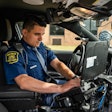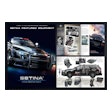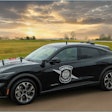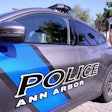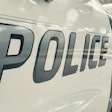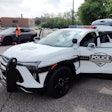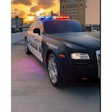When it comes to patrol cars, some law enforcement agencies have always wrestled with a variety of decisions. Ford? Chevy? Dodge? How fast? Marked or unmarked?
Now a new decision some agencies are making about their patrol cars is changing the way that officers treat their cars and the way that agencies treat their officers. Today, one of the most important decisions that an agency has to make about its patrol cars is whether to permit its officers to take the vehicles home and use them as both rolling police offices and personal transportation.
Arriving at the answer to this question is not easy. There are many factors and concerns that an agency's administrators must consider before letting an officer take home a police car. And there are advantages and disadvantages to take-home cars.
Saving Money, Saving Time
Patrol cars are often run 24 hours a day, seven days a week. With the wide range of driving conditions and demands placed upon them, keeping these black-and-whites clean and in good repair is likewise a full-time job.
In a bid to establish and maintain greater accountability for patrol car operation and upkeep, many agencies have found that when officers are assigned their own take-home patrol cars, they tend to be more responsible with them. This results in lower maintenance and repair costs. The practice also leads to increased visibility of police officers in the community and on the roadways.
There's another benefit to take-home patrol cars. They can help an agency fill its ranks. Police departments that offer take-home patrol cars often use them as recruiting tools. For example, the Website of the Pierce County (Wash.) Sheriff's Department promotes the availability of take-home cars for all deputy sheriffs as a "perk." Take-home cars have even been an acknowledged factor in why some officers left one agency for another.
Another great advantage to take-home cars for some agencies is that they no longer have to maintain facilities for storing patrol cars. They save money by not having to build secure parking areas.
But perhaps the biggest advantage of take-home patrol cars is the ready deployment of an off-duty officer to critical incidents. Because an officer has his or her gear and a car at all times, he or she can roll with a few minutes notice. The result is that off-duty officers can respond more rapidly to hostage, barricade, or active-shooter situations.
Insecurity System
Of course, there are also substantial negative concerns about take-home cars.
One that every administrator worries about is the legal exposure presented by take-home patrol cars. Does a police department run the risk of additional liability if an officer becomes involved in a traffic collision in a take-home car while off duty? This is something that each agency will have to address with its city or county manager and its legal counsel.
An even greater concern that some agencies don't recognize is the security of the car and its contents, including gear, uniforms, and guns. Last year in Garland, Texas, a tactical officer's patrol car was broken into. While the thief did not get any firearms, he did score a ballistic vest and other equipment.
The Garland burglary was not an isolated case. In December, a car burglar hit the jackpot when he smashed through the back window of a Dallas officer's take-home police patrol vehicle, pried through the backseat, and gained access to the trunk. Inside was $6,000 worth of equipment, including a high-caliber rifle, ammunition, a heavy-duty ballistic vest, and a SWAT uniform.
Similar scenarios have been played out elsewhere, with patrol car burglars and patrol car thieves gaining everything from access codes to department facilities, to names and addresses of police officers and contacts, to drug distributor lists and other documents that might compromise ongoing investigations and their investigators.
These days, with more and more agencies in the process of issuing patrol rifles such as AR-15s, the possible presence of serious firepower in take-home patrol cars is a growing concern. This is why some agencies that use take-home cars have policies prohibiting officers from leaving firearms in their patrol cars. Such a policy offered some solace to Deputy Chief Marion DeFillo of the New Orleans Police Department when several of his department's cars were burglarized.
Even when they don't contain guns, stolen patrol cars can be a major hazard for the public. Bad guys can use them to impersonate police officers. For example, a Florida teen borrowed his father's marked patrol car and used it to pull over a car driven by his estranged girlfriend.
Of course, the greatest fear regarding stolen patrol cars is what happens if they fall into the hands of really bad guys. In Israel and Saudi Arabia, public safety vehicles have been stolen and then employed in terrorist attacks.[PAGEBREAK]
Making You a Target
That's a quick look at the disadvantages of take-home patrol cars from the point of view of police administrators. But there are also some concerns about take-home cars that affect individual officers.
Having a take-home unit is a great benefit for a cop. It gives you another car for your personal use. But that car is your responsibility, and you can bet that, should something happen to it, you will catch it from your higher-ups.
Also, parking a patrol car in your driveway is kind of the equivalent of putting a flag on your house that says, "Police officer lives here." Most likely, your neighbors and friends know that you are a cop, and that's not a problem. But when you park a cruiser in your driveway, every ticked off teenager with a dozen rotten eggs knows that your house is a cop's house. Worse, so does every scumbag who's looking for some payback.
Selling the Concept
Of course, more people than just patrol officers and their administrators are affected by a take-home police car program. The public will have opinions and any agency will need public support or at least local government buy-in to make a take-home patrol program a reality.
Citizen perceptions of safety are a huge consideration when proposing take-home cars. Some communities want the perceived higher police presence and are willing to foot the bill. Others are less than enthused.
For example, when 90 percent of local citizens said that they felt safe in their community, Virginia Beach administrators had a difficult time justifying the expenditure of take-home cars for the city's police department. In this case, both the police chief and city manager agreed that the projected costs of replacing the current fleet and contracting maintenance for new cars would be too high, and it was generally agreed that officers might be the only ones to gain from the program.
Conversely, a study commissioned by the city of Tacoma, Wash., concluded that by allowing police officers to drive to and from work in their patrol cars, the city saved approximately $200,000 per year.
Bruce Mann, a participant in the Tacoma study, notes that the issue is contentious, disputed, oft-argued, and emotionally charged. "The real public policy issue should be: Will the community be better off or not with an assigned vehicle program?"
There are a lot of variables involved, and Mann says it's critical that cities and counties do the math before making a decision about take-home cars. "The answer depends on program finances, local political and community objectives, as well as the operational needs of the department," he says.
And unfortunately, analyzing the cost-effectiveness of a take-home program is not easy to do, nor is the final product usually very definitive. "Many of the dollars involved can be measured with only moderate difficulty," Mann explains. "Calculating values of some benefits and costs is complex due to their indirect assessment or their subjective nature. Citizen perceptions of safety, the deterrent effect of police visibility, morale effects, and the value of alternative uses of funds all need to be considered in any assigned vehicle program evaluation."[PAGEBREAK]
Implementing a Program
Once an agency does make a favorable decision about take-home patrol cars, it must have clear-cut guidelines as to the responsibilities of both the operating officer and the agency itself.
Key questions must be answered about maintenance and repair. These include: Who will be responsible for upkeep of the car? Who will be licensed to service the vehicle? When the black-and-white becomes disabled, will a private tow respond? If so, which one?
Another critical issue that must be determined before implementation is what the officer's permitted scope of vehicle operation will be while off duty. As Hanover, Ky., City Council Member Jeff Fant said during deliberations over the city's assigning take-home cars, "We don't want them driving to Louisville."
Influencing Factors
The very nature of some specialized assignments dictates that some officers be assigned their own take-home cars. For example, the modifications and equipment endemic to tactical vehicles precludes their rotational deployment in the field. Also, allergic officers would probably have a hard time inheriting a car that'd been used by a K-9 officer the shift before, so it's best to assign K-9 vehicles only to K-9 officers.
There are other reasons why an agency may feel that it's absolutely necessary to assign take-home vehicles to its officers. Ed Troyer, a detective with the Pierce County (Wash.) Sheriff's Department, says that the varied terrain, demographics, and crimes of his jurisdiction virtually require that deputies be issued their own patrol cars. "Like everyone else, we have budget constraints," he says. "We're undermanned and many of our guys have gravitated toward areas of specialized interest to compensate for a lack of funds. Beyond working regular patrol, many of our officers work on special details. The fact that they are often responding as part of a diving team, a search and rescue team, or a SWAT unit mandates that the tools unique to their expertise be readily accessible, whether they're on duty or off."
Troyer also notes that the department's take-home policy has collateral benefits. "First, most patrol cars may last a police department a year or two. Our patrol cars not only last from five to six years, but are so well-conditioned that, once stripped of our decals and pinstripes, they're often sold to smaller agencies," he says. "Beyond that, at shift change when half the guys are going home and the other half are coming on, we have twice the number of patrol cars on the road."
According to Troyer, Pierce County has leveraged the latest police technology to exploit all the advantages of its take-home patrol cars. "Our cars are mobile offices," he explains. "Our officers not only have cell phones issued to them, they can also [use their computers to] compose their reports in their patrol cars and send them to the station sergeant while in the field. The time saved in not having to come in the station to get reports approved or to gather and load up gear in patrol cars is remarkable. Officers can respond to crime scenes straight from their houses.
This means they can resolve situations more rapidly and have a better chance of containing and preserving perishable evidence. Finally, the community really likes seeing the patrol cars out in the neighborhoods and knowing that an officer is nearby."
Theft Prevention for Take-Home Units
Beyond ensuring that only the most responsible of officers are assigned take-home cars, there are a number of steps agencies can take to protect their vehicles and minimize potential liability from a take-home patrol car program.
After a burglar broke into a take-home patrol car assigned to a member of its SWAT team, the Dallas Police Department is installing alarms in its tactical cars.
In Pierce County, Wash., some of the more specialized sheriff's department cars have been alarmed, while other officers routinely secure their take-home cars in alarmed home garages, thereby obviating the need for alarms.
Another means of protecting the take-home patrol car is a unique anti-theft device manufactured by Tremco Police Products (www.tremcopoliceproducts.com).
Mark Tremblay, president of Tremco, says there's a compelling reason why more and more agencies are installing anti-theft devices and alarms in their cars. "The amazing truth is that an officer and his employing agency are more apt to get in trouble for some patrol vehicle-related matter than through anything involving the officer's duty weapon," he says. "When patrol cars get stolen, it's not only embarrassing for the involved agency, but the news media tends to have a field day with the matter, as well. And that's not even touching on the prospective liability."
Tremco's security system allows officers to even leave their patrol cars running unattended. "When officers pull up to an emergency situation, they place the shifter into the 'park' position and the anti-theft system is automatically activated," explains Tremblay. "Prisoners, drunks, and other unauthorized individuals are not able to shift the vehicle out of park. Law enforcement personnel, however, can quickly and easily deactivate the system and rapidly depart."
The Tremco system also provides protection for take-home cars when they are shut down and parked in an officer's driveway. "Our device gives 24-hour protection to vehicles when not in service, at the station or when taken home. If the key lock is destroyed, the shifter will not release. Not one vehicle containing a Tremco device has been stolen, even though many attempts have been made over the years," Tremblay says.











